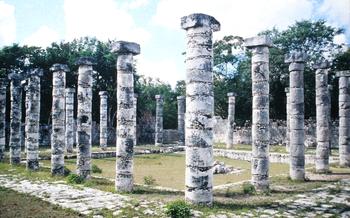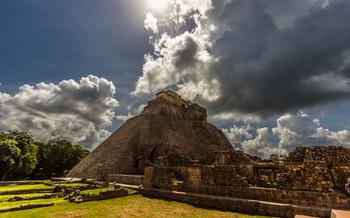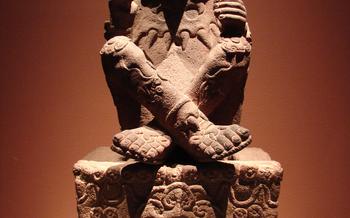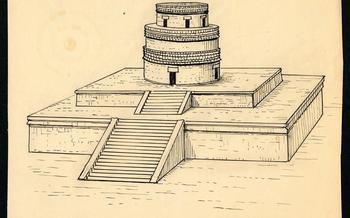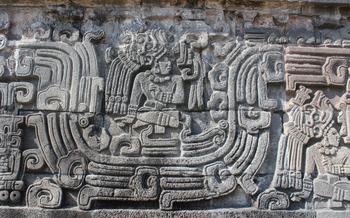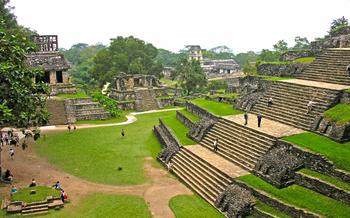
Zona Arqueológica de Izapa
- History of Izapa Archaeological Zone
- How to Get to Izapa
- What to See at Zona Arqueológica de Izapa
- The Monuments of Izapa
- Stelae
- Altars
- Miscellaneous Sculptures
- Unique Features of Izapa
- Izapa's Cultural Legacy
- The Stelae Museum
- Best Time to Visit
- Izapa's Natural Surroundings
- Accommodations and Restaurants
- Local Guides and Tours
- Photography Tips
- Insider Tip: Unveiling Izapa's Hidden Treasures
History of Izapa Archaeological Zone
The origins of the ancient city of Izapa remain shrouded in mystery, with no definitive consensus on its builders. It is widely believed that the Olmec and Maya peoples played significant roles in the city's construction and development, as evidenced by the blend of architectural styles and iconography found throughout the site.
Izapa flourished during the Late Formative period, a pivotal era in Mesoamerican history spanning from 400 BCE to 100 CE. During this time, Izapa served as a prominent ceremonial and religious center and witnessed the rise of complex societies and advanced artistic traditions.
The eventual abandonment of Izapa is attributed to a combination of factors, including environmental changes, political shifts, and the emergence of new regional powers. Despite its abandonment, Izapa's legacy endured, as its artistic and cultural traditions continued to influence subsequent Mesoamerican civilizations.
Through extensive archaeological research and excavations, scholars have uncovered a wealth of evidence suggesting that Izapa was a pivotal hub for cultural exchange and interaction. The city's unique iconography, often depicting stylized human figures and mythological scenes, reveals influences from various Mesoamerican regions. These artistic expressions provide valuable insights into the complex cultural dynamics and belief systems that shaped Izapa's ancient society.
How to Get to Izapa
Public Transportation: Izapa is accessible by public transportation from various cities in the region. From Tapachula, take a bus bound for Huixtla and then transfer to another bus going to Izapa. The journey takes approximately 3-4 hours, depending on traffic conditions.
Tours: Organized tours to Izapa are available from nearby towns such as Tapachula and Huixtla. These tours typically include transportation, a guided tour of the ruins, and lunch. Prices range from $40 to $60 per person.
Costs: The entrance fee to the Zona Arqueológica de Izapa is $75 pesos (around $4 USD) for foreign visitors. Visitors can also hire a local guide for approximately $200 pesos (around $10 USD) per hour.
Accommodations: There are a few budget hotels and guesthouses in the town of Izapa, offering basic accommodations at affordable prices. For a more comfortable stay, consider staying in Tapachula or Huixtla, where a wider range of hotels and amenities is available.
What to See at Zona Arqueológica de Izapa
The Zona Arqueológica de Izapa boasts a diverse array of structures, each offering unique insights into the ancient city's history and culture. Among the most notable ruins are the Great Plaza, a sprawling open space surrounded by impressive temples and pyramids. The Stela Plaza, another significant area, features a collection of intricately carved stone monuments depicting various deities, rulers, and mythical creatures.
The Great Pyramid, the largest structure at Izapa, stands as a testament to the city's architectural prowess. Its massive size and intricate carvings showcase the advanced engineering skills of the ancient builders. The Temple of the Jaguars, adorned with striking jaguar motifs, offers a glimpse into the sacred rituals and beliefs associated with this revered animal.
Izapa's iconography sets it apart from other Maya sites. The stelae and sculptures often depict non-Maya motifs, suggesting influences from neighboring cultures, such as the Olmec and the Zapotec. This unique blend of artistic styles adds to the site's allure and historical significance.
Several restored murals and stelae further enhance the visitor experience. These beautifully preserved artworks provide valuable insights into the daily life, religious practices, and artistic traditions of the ancient Izapa people.
The Monuments of Izapa
Izapa is renowned for its impressive array of sculpted monuments, which provide invaluable insights into the site's cultural and religious significance. These monuments can be broadly classified into three primary categories: stelae, altars, and miscellaneous sculptures.
Stelae
The stelae at Izapa are particularly noteworthy, standing as tall as 3 meters and intricately carved with a variety of motifs and symbols. These monolithic sculptures often depict human figures, animals, and supernatural beings, arranged in complex compositions that narrate mythological tales and historical events. The stelae at Izapa are distinguished by their unique style, characterized by deep relief carvings and a distinctive iconography that sets them apart from those found at other Maya sites.
Altars
Altars, another prominent type of monument at Izapa, served as platforms for religious rituals and offerings. These structures are typically rectangular in shape and feature intricate carvings on their surfaces. The altars often depict scenes of sacrifice, with human figures kneeling or lying prone, surrounded by various symbols and offerings. These carvings provide valuable insights into the religious practices and beliefs of the ancient Izapa civilization.
Miscellaneous Sculptures
In addition to stelae and altars, Izapa is home to a diverse collection of miscellaneous sculptures, including anthropomorphic figures, zoomorphic representations, and abstract symbols. These sculptures exhibit a wide range of styles and techniques, reflecting the artistic diversity and creativity of the Izapa culture. Particularly notable are the numerous jaguar sculptures, which hold special significance in Izapa's iconography and mythology.
Unique Features of Izapa
Izapa is renowned for its distinctive iconography and symbolism, which set it apart from other Mesoamerican sites. One of the most striking features is the prevalence of the jaguar motif. This powerful feline holds a sacred place in Mesoamerican mythology, symbolizing strength, rulership, and the underworld. At Izapa, jaguars are depicted in various forms, including sculptures, reliefs, and even as colossal stone heads.
Another unique aspect of Izapa is the abundance of carved anthropomorphic figures. These sculptures often depict individuals adorned with elaborate headdresses and garments, suggesting their high status or religious significance. The figures are often shown engaged in various activities, such as dancing, playing musical instruments, or performing rituals.
Izapa's stone columns, known as stelae, are also noteworthy for their intricate carvings. While stelae are commonly found at other Mesoamerican sites, those at Izapa stand out for their unique style and iconography. The stelae are typically carved with bas-reliefs depicting mythological scenes, historical events, or important figures. They provide valuable insights into Izapa's religious beliefs, social structure, and cultural practices.
Finally, Izapa's ball court is distinct from those found at other Mesoamerican sites. The court is unusually large and features a unique arrangement of stone benches or platforms along the sides. These platforms may have been used for seating spectators or for performing rituals associated with the game. The ball court at Izapa highlights the importance of the ballgame in ancient Mesoamerican culture and its role in religious ceremonies and social events.
Izapa's Cultural Legacy
Izapa's cultural legacy extends far beyond its physical remains. As a major cultural and artistic center, Izapa's influence radiated throughout the Mesoamerican region. Its intricate carvings and symbolic motifs were adopted and adapted by later cultures, leaving an indelible mark on Mesoamerican art and iconography.
Izapa's artistic style, characterized by its distinctive anthropomorphic figures, jaguar motifs, and intricate sculptural details, became a source of inspiration for subsequent Mesoamerican civilizations. The influence of Izapa's art can be seen in the iconography of the Olmec, Maya, and Zapotec cultures, demonstrating the far-reaching impact of Izapa's cultural legacy.
Beyond its artistic influence, Izapa played a pivotal role as a trading hub. Its strategic location facilitated the exchange of goods, ideas, and technologies with diverse regions throughout Mesoamerica. This flourishing trade network contributed to the dissemination of Izapa's cultural and artistic traditions, further expanding its sphere of influence.
The legacy of Izapa also lies in its enduring influence on religious and ceremonial practices. Its sacred structures and intricate iconography provided a framework for understanding the cosmological beliefs and ritual practices of the ancient Maya and other Mesoamerican cultures. Izapa's contributions to Mesoamerican religion and ritualism continue to resonate, shaping the spiritual and cultural traditions of the region to this day.
Contemporary scholarship has played a vital role in unraveling the complexities of Izapa's cultural legacy. Archaeological research, epigraphic studies, and interdisciplinary collaborations have shed light on the site's historical significance, its role in Mesoamerican trade and cultural exchange, and its enduring influence on subsequent civilizations. Ongoing research continues to uncover new insights into Izapa's cultural legacy, enriching our understanding of this ancient metropolis's profound impact on Mesoamerican history and culture.
The Stelae Museum
The Stelae Museum, located within the Zona Arqueológica de Izapa, houses a remarkable collection of stelae and other sculpted monuments that provide valuable insights into the history and culture of Izapa. These stelae, carved from large stone blocks, feature elaborate iconography and hieroglyphic inscriptions that depict mythological scenes, historical events, and the ruling dynasty of the ancient city.
The museum's exhibits showcase a diverse range of stelae, each with its own unique characteristics and significance. Visitors can admire the intricate carvings and detailed representations of gods, rulers, and mythical creatures. The hieroglyphic inscriptions, although not fully deciphered, offer glimpses into the written language and communication system of the Izapa civilization.
One of the most notable pieces in the museum's collection is Stela 5, which features a depiction of the Maize God, a central figure in Maya mythology associated with agriculture and fertility. The stela also includes a calendrical inscription that has helped scholars understand the chronology of the Izapa civilization.
Another highlight of the museum is Stela 1, which showcases a complex scene involving a ruler and a deity. The stela provides valuable information about the political and religious hierarchy of Izapa, as well as the interactions between rulers and divine beings.
The Stelae Museum serves as a treasure trove of knowledge about Izapa's rich cultural heritage. By studying the stelae and other artifacts, visitors can gain a deeper understanding of the beliefs, rituals, and artistic traditions of this ancient civilization.
Best Time to Visit
The best time to visit the Zona Arqueológica de Izapa is during the dry season, which runs from November to April. During this time, the weather is generally sunny and dry, with average temperatures ranging from 25 to 30 degrees Celsius. This makes for ideal conditions for exploring the ruins and enjoying the surrounding natural beauty.
The rainy season, which runs from May to October, can be a challenging time to visit Izapa. The weather is often hot and humid, with frequent rainfall that can make the ruins slippery and difficult to navigate. However, the lush vegetation during this time is also quite beautiful, and visitors may be able to experience the ruins in a more secluded and tranquil setting.
If you are planning to visit Izapa during the rainy season, be sure to pack appropriate clothing and footwear. You may also want to consider hiring a guide who can help you navigate the slippery terrain and point out areas that may be dangerous during the wet season.
Regardless of the time of year you visit, Izapa is a fascinating and rewarding destination. With its rich history, stunning scenery, and unique cultural significance, it is a place that is sure to leave a lasting impression.
Izapa's Natural Surroundings
The Zona Arqueológica de Izapa is nestled within a striking natural landscape, offering visitors a chance to immerse themselves in the region's rich biodiversity. The surrounding climate is tropical, characterized by warm temperatures year-round and abundant rainfall, particularly during the rainy season from May to October. The lush greenery that envelops the ruins is home to a diverse array of flora and fauna, adding to the site's allure.
As you explore the archaeological zone, keep an eye out for the region's fascinating wildlife. The skies above Izapa are often graced by soaring birds, including parrots, toucans, and majestic eagles. The dense vegetation provides a habitat for a variety of reptiles, amphibians, and mammals, including monkeys, snakes, and iguanas.
For those seeking a more immersive experience, several hiking trails and nature reserves are located in the vicinity of the ruins, offering opportunities to explore the region's natural wonders. The nearby El Ocote Biosphere Reserve is a popular destination, boasting a vast array of plant and animal life, including endangered species like the jaguar and the scarlet macaw.
To minimize their environmental impact, visitors are encouraged to follow sustainable practices while exploring Izapa. This includes staying on designated trails, avoiding littering, and respecting the local wildlife. By embracing responsible tourism, travelers can help preserve the natural beauty of this unique destination for future generations to enjoy.
Accommodations and Restaurants
When planning a trip to the Zona Arqueológica de Izapa, travelers have a range of accommodation options to consider. For those seeking a comfortable and convenient stay, several hotels and guesthouses are located in the nearby town of Huixtla. These establishments offer a variety of amenities, including air conditioning, private bathrooms, and on-site restaurants. Prices typically range from $20 to $50 per night, depending on the level of comfort and amenities offered.
For a more immersive experience, travelers can opt to stay in one of the nearby villages, such as Acapetahua or Pijijiapan. These villages offer a more authentic glimpse into local life and culture, with a variety of small hotels, guesthouses, and family-run bed and breakfasts to choose from. Prices in these villages tend to be lower, with rooms starting at around $10 per night.
Regarding dining options, visitors to the Zona Arqueológica de Izapa will find a limited selection of restaurants and cafes in the immediate vicinity of the ruins. However, the nearby towns of Huixtla, Acapetahua, and Pijijiapan offer a wider range of culinary experiences. These towns feature traditional Mexican restaurants, international cuisine, and local markets where visitors can sample fresh produce, street food, and regional delicacies. Prices for meals range from budget-friendly to mid-range, catering to a variety of tastes and budgets.
Local Guides and Tours
Navigating the Ruins with Expert Guidance:
Exploring the ancient ruins of Izapa is an enriching experience, but having a knowledgeable guide can enhance it tenfold. These local experts bring the site's history and significance to life, providing insights that would otherwise go unnoticed.
Hiring a guide offers several advantages. They can tailor the tour to your interests, whether you're fascinated by Izapa's art, architecture, or religious practices. They can also help you avoid crowds and access restricted areas, ensuring a more intimate and immersive experience.
When choosing a guide, look for those certified by the Mexican government or reputable tour operators. Inquire about their expertise, experience, and languages spoken to find one that suits your needs.
Group tours are also available, offering a more affordable option while still benefiting from a guide's knowledge. These tours typically follow a set itinerary and depart at specific times.
Recommended Tours:
-
Full-Day Tour from Tapachula: This tour includes round-trip transportation from Tapachula, a guided exploration of the ruins, and a visit to the Izapa Stelae Museum.
-
Half-Day Tour from Tuxtla Gutiérrez: Ideal for those short on time, this tour offers a comprehensive overview of the site's highlights, including the main plazas, temples, and stelae.
-
Customized Private Tour: For a personalized experience, opt for a private tour tailored to your interests and schedule. Discuss your preferences with the guide to create an itinerary that covers the aspects of Izapa that intrigue you the most.
Photography Tips
Capture the Essence of Izapa's Grandeur through Stunning Photographs
Harness the Power of Early Morning Light: Arrive at the archaeological site as early as possible to capture the ruins bathed in the warm glow of the rising sun. This golden light casts a magical aura on the structures, enhancing their grandeur and creating a sense of tranquility.
Experiment with Different Angles and Perspectives: Don't limit yourself to straightforward shots. Explore unique angles that showcase the ruins' scale and majesty. Try capturing the towering pyramids from below, highlighting their imposing presence, or experiment with aerial shots using a drone to capture the sprawling expanse of the site.
Focus on the Details: While capturing the overall grandeur of the ruins is essential, don't overlook the intricate details that make Izapa truly special. Zoom in on the finely carved glyphs, the intricate bas-reliefs adorning the stelae, and the expressive faces of the anthropomorphic figures to reveal the artistry and symbolism that define Izapa's unique iconography.
Embrace Black and White Photography: Consider converting your images to black and white to create a timeless and dramatic effect. The absence of color can emphasize the textures, shapes, and forms of the ruins, producing striking and evocative compositions.
Capture the Spirit of Place: Beyond the physical structures, strive to capture the spirit and atmosphere of Izapa. Photograph the surrounding landscape, the lush vegetation, and the vibrant wildlife that inhabit the area. These elements will add context and depth to your images, creating a more immersive and captivating visual narrative.
Insider Tip: Unveiling Izapa's Hidden Treasures
As you embark on your journey through Izapa, make sure to venture beyond the main ruins and uncover its hidden gems. One such treasure is the nearby community of El Duende, where you can witness the local artisans crafting exquisite replicas of Izapa's iconic sculptures using traditional techniques. Engage with these skilled craftsmen, learn about their artistic process, and perhaps even purchase a unique souvenir to cherish your Izapa experience. Additionally, consider visiting the Izapa Museum in the town of Tapachula, which houses an impressive collection of artifacts and stelae that provide deeper insights into the site's history and culture. By venturing off the beaten path and immersing yourself in the local community, you'll gain a richer understanding of Izapa's enduring legacy and the vibrant culture that surrounds it.
